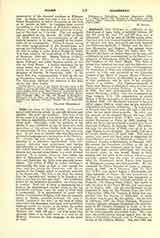

Allahabad, the Diocese of, suffragan of the Archdiocese of Agra, India, is included between 28° and 30° north lat., and 77° and 88° long. east of Greenwich. It has an area of 150,000 square miles. East and west it is situated between the Archdioceses of Calcutta and Agra, and north and south between the Prefecture-Apostolic of Bettiah and the Himalaya Mountains and Nagpur. The mission dates its origin from 1669, when the Right Rev. Dr. Matheus de Castro, an Indian from Goa by race, and a Brahmin by caste, was entrusted by the Sacred Congregation of Propaganda with the spiritual care of the kingdom of the Great Mogul. This field of labor was, however, too vast, and the laborers too few. Hence it was that, by a decree of Propaganda, the Prefecture of Tibet and adjoining countries was erected, in 1703, and entrusted to the Capuchin Fathers of the March of Ancona (Marta d’Ancona) Province. The Diocese of Allahabad is an offshoot of that prefecture, and its more or less complete history is as follows: The Vicariate-Apostolic of Patna (now Diocese of Allahabad) when founded was entrusted to the Capuchin Fathers. It was erected in 1845. The first vicar-apostolic was Dr. Anastasius Hartmann, O.M.C., who was nominated by Pope Gregory XVI. His consecration as titular Bishop of Derbe took place in the cathedral of Agra, March 13, 1846. Dr. Hartmann remained at his post till August 16, 1849, in which year he was appointed Administrator-Apostolic of Bombay. He took charge of the new office the same year, and held it till 1854, when he was made vicar-apostolic. He ruled over the destinies of the Bombay Mission till June, 1858. When Dr. Athanasius Zuber, O.M.C., who had succeeded Hartmann at Patna in 1849, resigned his office, the latter was nominated a second time Vicar-Apostolic of Patna, January 24, 1860. The following year the provinces of Oudh were given by the Agra Mission to his vicariate. His death took place at Coorjee (Bankipore), April 24, 1866. This zealous prelate, who spent ten hard years in organizing the Patna Mission, was born at Hitzkirch, a village in the canton of Lucerne in Switzerland, February 24, 1803. He entered the Franciscan novitiate at the age of eighteen, and was ordained priest in 1826. As he had taught logic, natural philosophy, and theology for eleven years, he was deeply versed in those sciences and was quite in his element whenever any scientific subject was the topic of conversation. After Dr. Hartmann’s death, Father John Baptist of Malegnano became pro-vicar-apostolic. He was succeeded by Father Benedict of Assisi as administrator, in 1867. On February 9, 1868, Dr. Paul Josi, O.M.C., was elected Bishop of Rhodiopolis and Vicar-Apostolic of Patna. He was consecrated on June 28 of the same year, but was transferred in 1881 to the newly-erected Vicariate-Apostolic of the Punjaub. Dr. Francis Pesci, O.M.C., was chosen to take his place in the Patna Mission and consecrated on August 14, 1881. On the establishment of the hierarchy in India by His Holiness Pope Leo XIII, September 1, 1886, the Vicariate of Patna was constituted into the Diocese of Allahabad, of which Dr. Pesci then became the first bishop. On the 24th of February, 1887, the Papal Delegate, Monsignor Antonio Agliardi, solemnly proclaimed the establishment of the Catholic hierarchy in India, in St. Joseph‘s cathedral, Allahabad, at a meeting attended by the vicars-apostolic of northern India. The same year, the newly-erected diocese parted with the districts of Darjeeling, Purneah, and the Pergunnas, in favor of the Calcutta Mission. The year 1890 was remarkable for two important events in the history of Allahabad. The first was the holding of the Diocesan Synod in the cathedral. The second was that the mission was entrusted by the Sacred Congregation of Propaganda to the Capuchin Province of Bologna, Italy. In 1892, the districts of Chupra, Mozafforpur, Darbhunga, Bettiah, and a part of the Bhagalpur and Munghyr districts, and the Kingdom of Nepal were made the Prefecture Apostolic of Bettiah and Nepal. On July 9, 1896, Dr. Francis Pesci, Bishop of Allahabad, died at Lyons, France. Father Charles Gentili was chosen to be his successor, March 29, 1897. He was consecrated on June 29 of the same year and transferred to Agra, August 27, 1898. On the corresponding date of the following year, Father Victor Sinibaldi was nominated bishop, and consecrated, November 30, 1899. His pastoral rule was shortlived, as he died, January 5, 1902. On the 10th and 12th of November, 1903, the first General Congress assembled at Allahabad, at which were present two archbishops, one bishop, two administrators-apostolic, one prefect-apostolic, three superiors-regular, thirty priests, and more than 200 delegates. When Bishop Sinibaldi died, Father Petronius Gramigna ruled the diocese in the capacity of administrator, from 1902 to August 10, 1904, when he was nominated bishop, and consecrated in St. Joseph‘s cathedral, October 18, 1904.
The Catholic population of the diocese is 8,800, out of a total of 38,174,000, mostly composed of Mussulmans and Hindus. Benares, the sacred city of the latter, and the center of their religious activity, lies within the limits of the diocese. There are in the mission 22 Capuchin Fathers, 3 secular priests, 18 Christian Brothers, 2 Brothers of the Third Order of St. Francis, 74 nuns of the Institute of the B. V. M., 9 Loretto nuns, 7 Sisters of the Third Order of St. Francis. There are six orphanages, male and female, with about 450 boys and girls. The number of educational establishments is 4, consisting of colleges, convents, high schools, boarding- and day-schools, with 1,468 pupils of both sexes.
MANOEL DSA

